NJAGC’s November meeting was held at the beautiful home of Laurie S., in Ringwood, NJ.
| Jerry | Adrian | Frank |
| Laurie | George | Niki |
| Ross | Patrick | Khanh |
| Paula | Aram | Alex |
| Ken | Phil | Kara |
| Darin | Darek | John |
| Ted | Clay | Jim L |
Activities commenced when President, Jerry called the meeting to order at 1:16pm. Ted T. and his son, Clay were introduced as guests and John M. was recognized for having this meeting be his first attended.
A few topics were discussed, such as club memorabilia and any plant or fish related upcoming events. Many were saddened to hear that this was Ken’s last meeting as he will be moving to Arizona, but will remain present on the forum. Ken was nice enough to donate 50% of the proceeds of his aquatic equipment that will be auctioned off in months to come. He was given a farewell card, signed by all members present at the meeting.
The group’s treasurer, Phil gave a brief financial statement presenting current profit and expense report. He also encouraged the group to distribute club business cards, to which he proceeded to give some out to newer members.
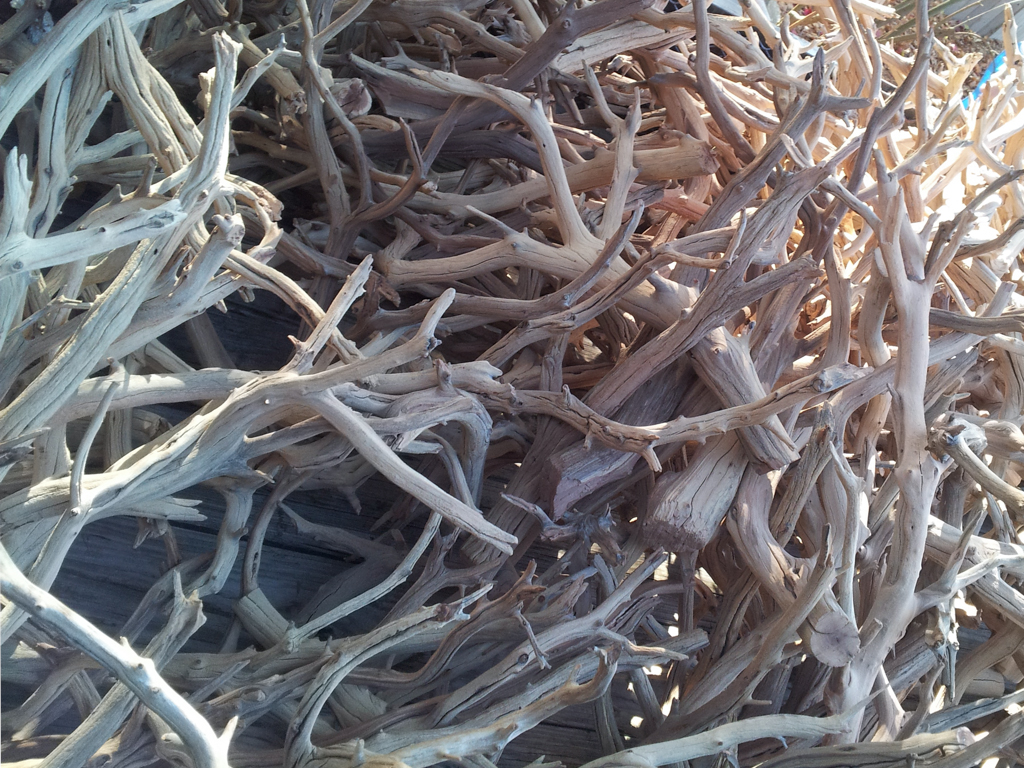 The ghost wood [driftwood] that both the club and individual members purchased was held outside. Those who prepaid will be the first to pick out their pieces.
The ghost wood [driftwood] that both the club and individual members purchased was held outside. Those who prepaid will be the first to pick out their pieces.
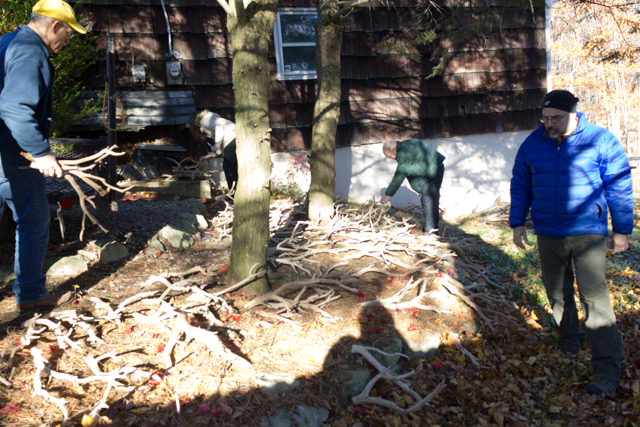 Club dvds and books are available for borrowing, see Jerry for more information. Khanh will also be getting a hold of some additional books.
Club dvds and books are available for borrowing, see Jerry for more information. Khanh will also be getting a hold of some additional books.
At this point, the meeting was turned over to the host to discuss her 6 tanks. In addition to her planted tanks, Laurie keeps and breeds Endangered Madagascar Cichlids as she is part of a conservation project to ensure their survival. The largest of her tank collection is a 125g, 6’ long tank.
It hosts Design by Nature 3d background, foraged wood, river rock, custom blend broadcast medium Permaquartz substrate, Fluval FX6 and Eheim 2217 canister filters with a hydor power head, Sera 300w heater, and LED lighting. The stock in this tank consists of Madagascar Cichlids; Paratilapia polleni ‘marakely’ large spot, juvenile Paretropolus Menarambo, Maculatus & Kieneri. A group of 6 clown loaches also occupy this tank. A breeding pair of Madagascar’s Ptychochromis sp. ‘tarantsy’ and their offspring are kept in two other tanks.
Par readings were taken in her 110g tall tank as concern was expressed to the limited number of plants that can be grown within.
Readings showed that due to the depth of the water, light is not penetrating as strongly to low level plants that are in the substrate.
This was evident by a 20-par reading at the bottom, a 40-par reading in the middle, and a 62-par reading at the top.
The last activity before the meeting officially ended was the rescaping of a 55g long tank.
Although it was a community driven rescape, it was primarily executed by Darek the NJAGC’s moderator. Towards the end of this activity some members began their treks home as others remained hours later discussing plants, fish, saltwater and freshwater aquariums and much more.



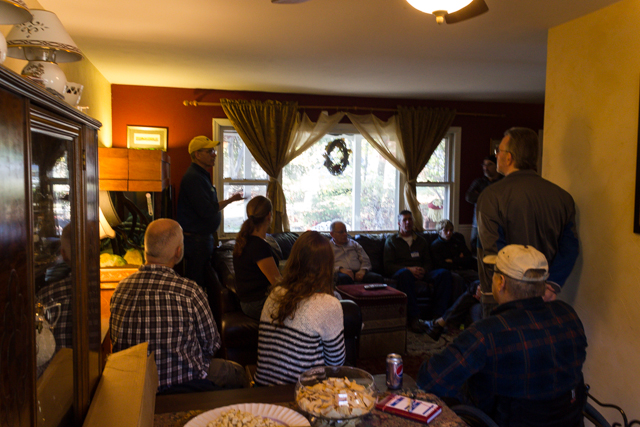
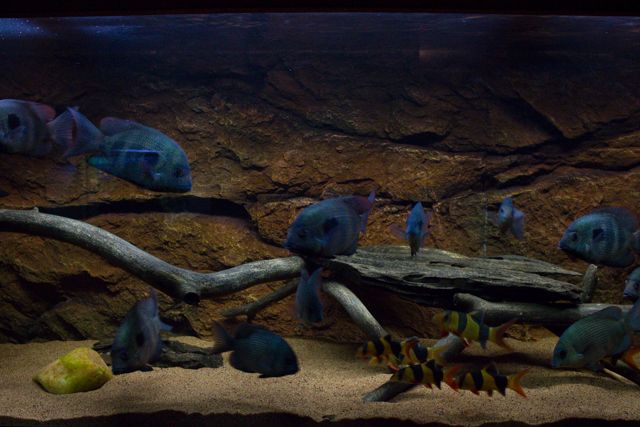
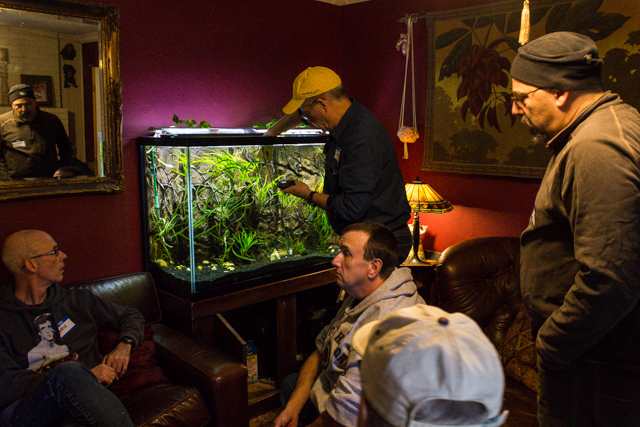
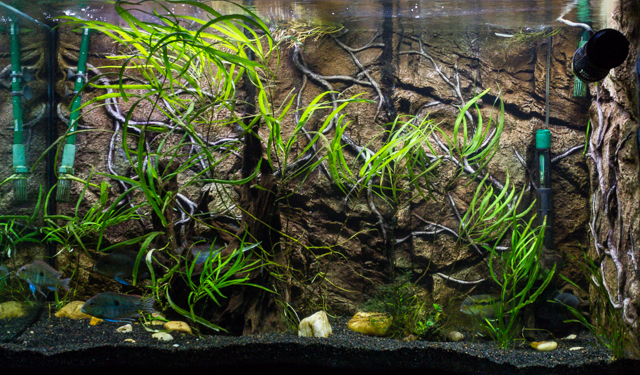
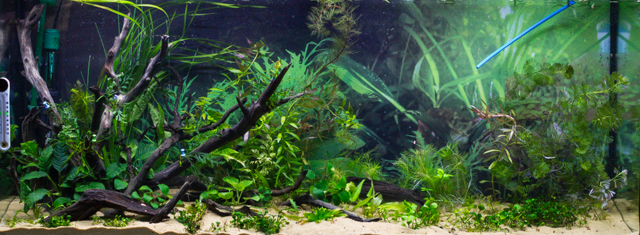
Pingback: November 2014 Meeting - New Jersey Aquatic Gardeners Club - Aquatic Plant Central
Hello,
I’m interested in using “ghostwood” in an aquascape – which, I believe, is a variety of sagebrush (Artemesia tridentata).
In your collective experience, is “ghostwood” safe for fish and invertebrates?
Thank you!
Its safe and I’m using it in my 125 and 40 breeder. I’m not sure about others but I experienced heavy leaching. Even now almost 2 months later my water is still a little brown but it depends on how much wood you have. I put 15 pieces in my 125 and the tank turned brown within two days. I didn’t check parameters but I’m guessing ph dropped. It sinks fairly easily I would say within two weeks you should be able to do whatever you want with it. It depends on the size of the wood though. The bigger the piece the longer it takes to sink.
I hope that helps.
Following is a reply from Laurie -NJAGC member
We are using this wood as well. Its in four different tanks. I’ve found it takes a week to ten days to sink in our tanks, for the small pieces. It floats for a few days, then starts to sink so I weigh it down with rocks. I haven’t noticed any significant leaching, no pH drops. The wood quickly turns a very dark brown. I’m guessing the water parameters of each tank will have an effect on the wood. Since we use ro/di water, seachem equilibrium and acid/alkaline buffers I don’t see the wood affecting parameters in our established tanks.
If I didn’t think it was safe for fish, it certainly wouldn’t be in our tanks. We don’t keep inverts. It ?may? possibly effect fish that are delicate and require different parameters than one would find in tanks with driftwood and lower pH, GH/kh, etc. But then again, wood still wouldn’t be a primary factor.
Following is a reply from Kara -NJAGC member
Just redid my betta tank and added some. Sank immediately (Though to be fair parts of it are coming out of the tank, however it had 0 buoyancy and laid where I wanted it to). I have heavy tannins right now but a bag of seachem purigen in your filter clears that up in a day or two. Just checked the PH (I set this tank up wednesday) and its 7.5. So it lowered the PH about .2-.3. Wood is very dense, if you want to cut it go for an electric saw, my little hack saw took forever. But a palm sander worked just fine to shave down all the sharp edges, I used 80 grit.
Wood also takes on a nice marbled red and blonde hue when wet.
Hello I am new to planted aquariums and would like to learn more…I would love to come to your next meeting and would like to known when the next one will be held?
Please navigate to join us page and fill out the request form to join our club. Meeting locations vary depending on host availability but, the next meeting is on Saturday, March 28th in Glendora, NJ.
Thanks